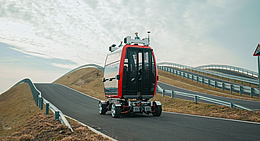The 48-meter-high Eder Dam in North Hesse, which was built between 1908 and 1914, impounds Germany’s second-largest reservoir in terms of area and third-largest in terms of volume, with a length of 28.5 kilometers. In 1943, during the Second World War, the dam was severely damaged in a bombing raid and was rebuilt in the same year using slave labor. After the war, the mountainous landscape around the Edersee, which includes the Kellerwald-Edersee National Park, grew rapidly in importance for tourism as a recreational area for a wide range of activities. One of the attractions is Waldeck Castle, which has given its name to the sregion. The castle, which dates back to the 12th century and has been rebuilt several times, now houses a museum and a hotel plus restaurant.
Pioneering idea for the tourism industry
When the Waldeckische Landeszeitung ran an article on April 1, 1958 about a plan to build a cable car from the lake shore to the Waldeck Schlossberg, people thought it was a joke for April Fool’s Day. However, the 1960 total of 2.1 million bednights in the Waldeck Holiday Region suggested that the investors could take a sanguine view of the future. And in 1961, thanks to the initiative of Achim Wickmann, a real estate agent from Kassel, who was quick to recognize the region’s potential for tourism, this “April Fool’s joke” became reality.
After a short construction period, the Waldeck Cable Car, built at a cost of 1.3 million German marks, was inaugurated on March 28, 1961. The gondola lift has a line length of 650 m for a vertical rise of 100 m and, with its 28 2-passenger cabins, a transport capacity of 360 pph per direction. The cable car saves visitors the arduous climb up to the Schlossberg. It is the last installation to have been built by the long-established German ropeway manufacturer Pohlig of Cologne before the merger of the three German companies Pohlig-Heckel-Bleichert to form PHB in 1962. Along with the Westphalia Park Cable Car, the ropeway serving Waldeck Castle is now the last surviving Pohlig gondola lift with Giovanola grips. So after six decades of operation, it is not just a nostalgic ropeway, but a living piece of German ropeway history.
Traditional ropeway engineering company
Julius Pohlig started manufacturing material ropeways back in 1873. With the inauguration of the aerial tramway serving the Sugar Loaf Mountain (Pão de Açúcar) in Rio de Janeiro (opening of the 1st stage in October 1912 and the 2nd stage in January 2013), the Pohlig company became world famous. The Waldeck Cable Car is a (very) distant cousin of the Sugarloaf Cable Car, because Pohlig’s mechanics overhauled the aerial tramway in Rio de Janeiro in 1960 and then came straight to Waldeck to build this little gondola lift.
For its detachable monocable circulating ropeways, Pohlig used the Giovanola automatic gravity grip. Until the mid-1980s, this grip was the most common detachable grip in the world and was used by such manufacturers as Habegger, Städeli, PHB, Ceretti & Tanfani and Breco.
Preservation or new installation?
The lift operates from the beginning of April to the end of October and, in addition to the 28 passenger cabins, it also has two carriers that can transport up to four bikes. An annual total of about 100,000 visitors use the Waldeck Cable Car, which has never received any public funding. It is one of the few German ropeways to be run on a purely private basis. Many operations are still performed manually, such as releasing the cabins onto the line, moving the cabins through the stations, and opening and closing the cabin doors.
While the Waldeck Cable Car scores with its passengers for its historical charm and nostalgia value, it is no longer equal to expectations in terms of modern systems and a comfortable ride. Even though the operating license has been extended for another ten years by the Kassel state authorities, thanks above all to years of perfect maintenance, the operators are now giving thought to the question of modernizing the installation. In the future, they would also like to offer transportation for wheelchairs and additional capacity for bikes. However, these and other changes are only possible with a corresponding capital investment. For that reason the company is looking for a new model of participation and operation that would spread the financial burden over more shoulders in order to get the cable car fit for the future.
Plans for a completely new ropeway at Edersee are now the subject of heated debate – because, without dismantling the old Waldeck Cable Car, there will be no planning permission for a new installation.



![[Translate to English:] Foto: Leitner](/fileadmin/_processed_/a/8/csm_Vertragsunterzeichnung_Narvik_6_copyright_LEITNER_print_501f2d5c24.jpg)


![[Translate to English:] (c) Doppelmayr](/fileadmin/_processed_/b/3/csm_85-ATW_Stechelberg-Muerren_Lauterbrunnen_CHE_001_6442c0520d.jpg)







